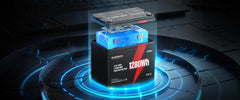
Deep Cycle Batteries Explained: What They Are, How They Work, and Why You Need One
, 9 min reading time


, 9 min reading time
Deep cycle batteries are a key power solution across a wide range of applications, from RVs and boats to solar power systems, fishing gear electronics, and off-grid living. Unlike standard starter batteries, they are built to deliver steady power and handle deep discharges repeatedly, making them essential for reliable, long-term energy storage.In this article, we'll walk you through the fundamentals of deep cycle batteries, including what they are, how they work, different types, charging tips, lifespan comparisons, real-world uses, and how to choose the right one.
A deep cycle battery is engineered to provide a steady amount of power over an extended period and to be deeply discharged—up to 70% to 80% of its capacity—without damage. This is known as Depth of Discharge (DoD), which refers to how much energy is used relative to the battery's total capacity.
|
Battery Type |
Primary Use |
Key Characteristics |
|
Starter |
Engine cranking |
Delivers high current briefly |
|
Deep Cycle |
Continuous power |
Stable output, built for deep cycles |
Choosing the right type of deep cycle battery depends on your specific application needs, operating environment, and budget. Here's a comparison of the most common types:
|
Battery Type |
Pros |
Cons |
Best For |
|
Flooded Lead-Acid |
Affordable, widely available |
Requires maintenance, leaks acid |
Budget solar setups |
|
AGM (Absorbent Glass Mat) |
Sealed, maintenance-free, shock-resistant |
Expensive, sensitive to overcharging |
RVs, marine, off-grid homes |
|
Gel |
Handles extreme temps, no leaks |
Slow charging, high cost |
Hot/cold environments |
|
LiFePO₄ (Lithium Iron Phosphate) |
Lightweight, 3000+ cycles, fast charging |
High upfront cost (but long-term savings) |
Premium RVs, Fishing, Solar |
❌ Wrong charging = Reduced lifespan or failure
✅ Correct charging = Maximizes performance & longevity
|
Battery Type |
Charging Notes |
|
Flooded Lead-Acid |
Regularly check and refill water levels, avoid overcharging |
|
AGM/Gel |
Use a compatible smart charger; avoid high voltages |
|
LiFePO₄ |
Requires a lithium-specific charger with BMS support |
The lifespan of a deep cycle battery depends on several factors, including battery chemistry, depth of discharge (DoD), charging habits, and operating temperature.
|
Battery Type |
Cycle Life (at 80% DoD) |
Typical Lifespan |
|
Flooded Lead-Acid |
300–500 cycles |
2–4 years |
|
AGM |
500–800 cycles |
3–6 years |
|
Gel |
500–1000 cycles |
4–7 years |
|
LiFePO₄ (Lithium Iron Phosphate) |
3000–5000+ cycles |
8–12+ years |
• Limit deep discharges (Keep DoD below 50% for lead-acid, below 80% for LiFePO₄)
• Store at 40–60% charge if unused for extended periods
• Keep batteries in a cool, dry location with partial charge during storage
• Use a battery monitor to track voltage, state of charge, and health
Yes — in fact, a deep cycle battery is one of the best power sources for Garmin LiveScope, a sonar system that provides real-time underwater imaging.
|
Battery Capacity (Ah) |
Estimated Runtime |
|
20Ah |
6–8 hours |
|
50Ah |
Up to 16+ hours |
Pro Tip: Use a waterproof battery case for protection in wet environments, and always ensure your charger is compatible with lithium batteries.
|
Use Case |
Recommended Type |
|
RV/Camper |
AGM or LiFePO₄ |
|
Fishing Electronics |
LiFePO₄ |
|
Solar Storage |
Flooded Lead-Acid or LiFePO₄ |
❌ "Deeper discharges are better." → False. They shorten battery life.
❌ "Any 12V battery works the same" → False. Chemistry and specs matter.
❌ "Car batteries can replace deep cycle" → False. They're not designed for deep cycles.
❌ "Batteries in parallel don't need to match" → False. Mismatched batteries cause an imbalance.
Q: Can I connect deep cycle batteries in series/parallel?
A: Yes. But only connect identical batteries (same type, age, and capacity) to avoid imbalance.
Q: How should I store unused deep-cycle batteries?
A: Store at 40–60% charge in a cool, dry location. Check and top off every 3–6 months.
Q: Can I use a lead-acid charger for LiFePO₄ batteries?
A: No. Always use a LiFePO₄-compatible charger with BMS and CC/CV profile.
Deep cycle batteries are the backbone of long-lasting, reliable energy storage in mobile, marine, and off-grid systems. By understanding how they work and how to care for them — and by choosing the right battery for your application — you’ll get the most out of your investment.
Whether you’re outfitting an RV, setting up solar power, or casting with LiveScope, the right deep cycle battery can power your adventures with confidence and consistency.